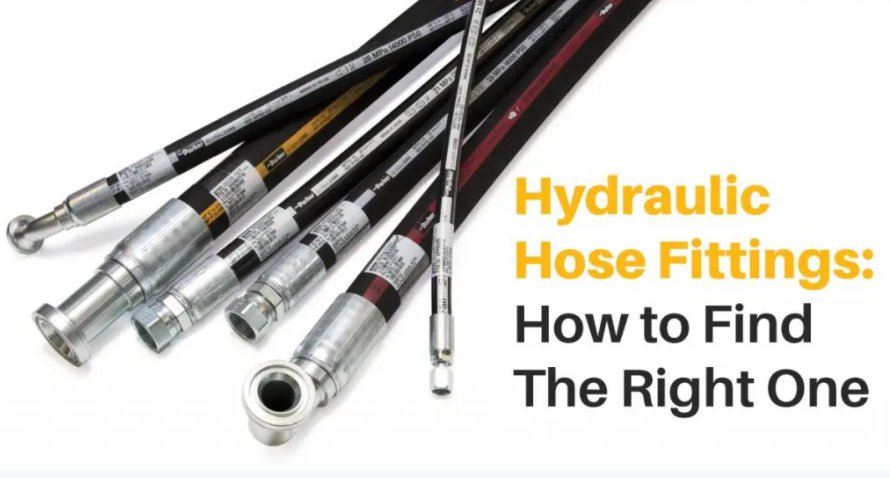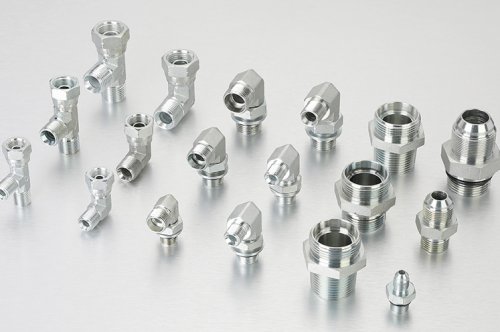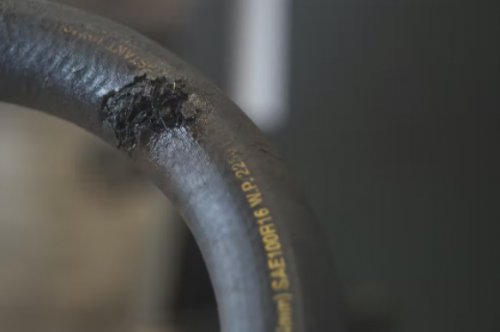Hydraulic Hose Fittings. How to Find The Right One

Hydraulic hose fittings are used to connect hydraulic hoses, tubes, and pipes to pumps, valves, cylinders and other parts of the hydraulic system. So what happens if you pick a wrong fitting? Unfortunately, something as small as a fitting can quickly decrease the efficiency of the whole hydraulic system and even pose a major safety issue. If you get too overwhelmed with the shapes, materials, threading, and sealing options to choose from, save your time, and check our guide on how to pick the right fitting best for your job.
Hydraulic Hose Assembly Explained
For many of us, the first time we have to decide on which type of hydraulic hose fitting to use is during the hose assembly. Crimping is the most popular method assembling the hydraulic hose. It is always a good idea to ask yourself five major questions about S.T.A.M.P. (size, temperature, application, materials/media, and pressure) before you get started with any hose assembly. Once the specifications have been defined, the hose assembly technician can get to work. The process can vary by crimper model, but typically the technician marks the insertion depth on the hose, applies lubricant to the fitting stem, pushes it inside the end of the hose, and inserts it into the crimper die. Finally, the technician secures the fitting permanently onto the hose by activating the crimper’s power unit to apply pressure. The hose assembly technician would be able to assist you in finding the best fitting and assist you with any questions.
Materials Hose Fittings Are Made Of
Hoses, as well as fittings, come in many different types and materials. Importantly, the material used for the hydraulic hose fitting defines its properties. Most common fittings are made of plastic, steel, stainless steel, or brass.
Plastic fittings generally are considered more resistant to the corrosion but are weaker and less durable. Therefore, they are the least popular choice when it comes to hydraulic applications despite their low price. Due to the high-pressure ratings, metal fittings are a better fit.
Steel fittings come as a mix of iron with some other metals to make them more durable and improve the resistance to the heat. For example, carbon steel fittings made of the mixture of iron and carbon can withstand the temperatures from -65°F to 500°F.
Stainless steel fittings are used when the temperature range required for the job is -425°F to 1200°F. They are an excellent choice for highly corrosive environments. Usually, they are rated up to 10,000 psi. Some of the stainless steel fittings with special designs can be rated up to 20,000 psi. However, the high price makes them less affordable, so other alternatives are usually considered.
Brass fittings are less strong and durable than stainless steel. They can provide a leak-free operation and meet SAE, ISO, DIN, DOT, and JIS standards. Brass fittings temperature range is -65°F to 400°F. They accommodate pressure up to 3000 psi, but lower pressure ranges are usually recommended.
Less commonly used hose end fitting materials
Aluminum fittings are significantly lighter than steel and are corrosion-resistant. Due to their low weight, they are commonly used in the automotive industry.

Types of Hydraulic Hose Fittings
The two main categories include:
-
Permanent Crimp Fittings – the most common type of fittings. They require a presence of the crimping machine to attach a hose to a fitting.
- Field Attachable – They are an excellent choice if you do not have access to the crimper provided that your hose is ‘field attachable fitting’ compatible.
Depending on the shape of the hydraulic fitting, they classified into:
-
Plugs
-
Unions
-
Elbows
-
Crosses
Six Things to Consider When Picking the Hydraulic Fittings:
-
-
The Security of the Connection Including Sealing Type
Be careful if you use NPT (National Pipe Taper) pipe threads fittings. Even though it sounds easy to fix the leak with this type of fitting by tightening the connection, you increase the risk of getting a crack in the fitting. This is more likely to happen with repeated remakes (loosening and re-tightening the fitting). Use O-rings with the elastomeric seals such as DIN 2353, SAE J1453 to prevent the risk of unexpected leaks and switch to an untapered JIC fitting. If you use elastomeric seals, keep your temperature conditions within the recommended range. Unfortunately, even a single over-temperature event can damage all the seals and cause multiple leaks.
-
Pressure Rating
With the modernization of your equipment usually comes higher operating pressure. To address high operating pressure, more and more of our customers prefer to use O-ring seals. They are more resistant to cracks. O-ring seals also prevent the risk of over-torqueing and leakage. In terms of material stainless steel hose fittings have the highest pressure rating.
-
Vibration
Vibration affects hydraulic plumbing and can shift the torque and cause fatigue. Remember to inspect areas with high vibration for leaks and damage.
-
Temperature
The temperature range for tube fittings is defined by three factors: material, plating, and seal if used. For leak-free operation use O-ring seals if the operating temperature allows you. Check the table below for the temperature range for the most common fitting and seal materials.There are special options available if you need hydraulic hoses and fittings to work under extreme temperature conditions. Contact us to learn more.
-
Chemical Compatibility and Operating Fluid
A rule of thumb says that hose inner tube, cover, fittings and O-rings should be chemically compatible with each other. Pay extra caution when selecting a hose for gaseous applications, especially if there is a chance of permeation in order to avoid explosions, fires, and exposition to the toxic fumes. Always check with the manufacturer if the components of your hydraulic system are chemically compatible. Additionally, pay close attention to your seal being compatible with the type of hydraulic fluid used in a system. The Guide for Chemical Resistance Information from Parker can be found here.
-
Availability
It all goes great until you need a replacement fitting and the lead time is a couple of weeks, and you need it now. Usually, most NPT and JIC fittings are widely available and have many configurations to choose from. Hence, choose the fittings that are easier to find or stock up if you use any specific fitting with longer lead times.
-
Mixing and Matching
Both SAE and ISO do not recommend mixing hose end fittings and hoses from different manufacturers. There are plenty of good reasons for this, but best reason to not do it is safety. Mixing a fitting from one manufacturer with another manufacturer’s hose could result in a failure or rupture at the crimp because the two products are just not compatible. The manner which the fitting is secured to the hose and the allowable tolerance for the hose crimp may differ. For example, the range for Parker’s allowable tolerance for a crimp can be as little as 0.02 inches and the range may not overlap with the other manufacturer’s product. Further, a manufacturer will not take responsibility for a failure. Therefore, if you intermix your hose and fitting from two different manufacturers, you should seriously reconsider.
What’s next?
It is important to remember to inspect your hoses and fittings for a secure connection and any leaks every couple of months. Even new fitting, if it was selected wrong, can cause problems. Although picking a hydraulic fitting sometimes feels overwhelming, if you follow our simple guide, it should not be a problem anymore.
If you want to learn more about selecting hydraulic fittings, contact us to speak with a fluid connector specialist.
 中文
中文
 English
English




